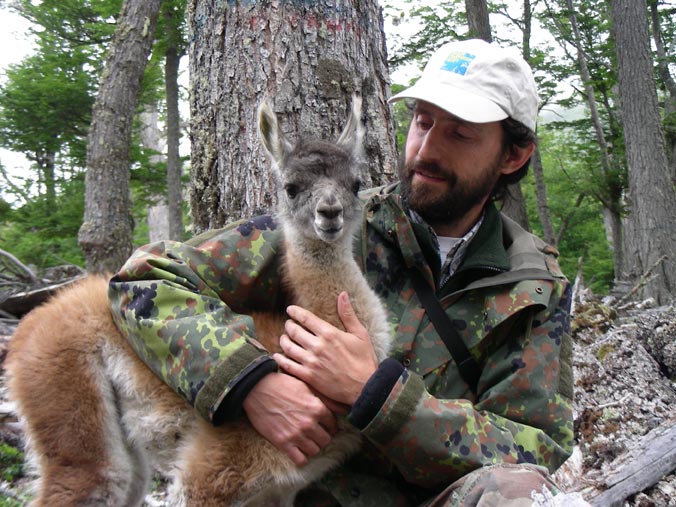WCS Radio Collars Iconic South American Mammal

WCS WCS’s Andrés Novaro examines a young guanaco before releasing it.
Where the Guanaco Roam: New Study Documents Wanderings of South America’s Iconic Hoofed Mammal
• Guanaco populations rebounding in Tierra del Fuego now come in conflict with sheep ranchers and loggers
• WCS scientific team radio collared guanacos and followed them in and around Karukinka Natural Park in Chile
• Guanacos are wild cousins to llamas
• Study: online edition of journal Oryx
Guanacos are back – and getting into trouble – says a team of scientists from WCS (Wildlife Conservation Society) tracking these iconic hoofed mammals across a variety of landscapes on the Chilean side of the island of Tierra del Fuego.
The team says that guanacos – wild cousins to domestic llamas – are coming into increased conflict with sheep ranchers and loggers. The results of their study indicate that better understanding guanacos’ seasonal movements, coupled with a limited science-based, sustainable a harvest of animals, may be the key to conserving this quintessential species of Tierra del Fuego.
The study appears in the online issue of the journal Oryx. Authors include: Claudio Moraga, Martín Funes, Cristóbal Pizarro, Cristóbal Briceno and Andrés Novaro of WCS.
Guanacos once numbered in the many millions in South America. In Tierra del Fuego, by the mid 1970s as a result of hunting, competition from sheep, and habitat degradation, the guanaco population had collapsed to approximately 7,000 individuals on the Chilean side of the island. Since then, guanaco numbers have recovered to more than 60,000 as a result of hunting restrictions and reduced sheep numbers.
The WCS team conducted seasonal counts of guanacos and fitted 10 animals with radio collars in and around Karukinka Natural Park, a vast wilderness owned and managed by WCS as a protected area. Before the animals were released, blood samples were taken so that the scientists could conduct complementary health and genetic tests.
The team found that while some guanacos were more sedentary, others conducted seasonal migrations spending time in grasslands in the summer and forests in the winter sometimes even crossing into Argentina. Once they ventured outside of the park, they often came into conflict with sheep ranchers and loggers.
High sheep densities and poor range conditions on the ranches reduced key forage resources available to guanacos forcing them into forests where they fed on seedlings affecting forest regeneration and increasing conflict with logging interests.
Guanaco density was highest in low-elevation areas with more grassland cover and little snow accumulation in winter. In these areas, guanaco density decreased with increasing livestock density.
Said lead author Claudio Moraga of WCS: “Our results provide insight into the interactions among guanacos, forests and livestock ranching, and may be used to reduce conflicts and guide conservation of Tierra del Fuego’s unique ecosystems. Ultimately, conservation of these ecosystems depends on reconciling the interests of livestock husbandry, guanaco conservation, and the timber industry.”
Chilean authorities hope that the sale of guanaco meat from recently allowed legal harvests will be viewed as a contribution to the economy of the Magallanes region. The authors say that harvesting guanacos may be a useful tool to promote guanaco conservation in parts of Tierra del Fuego, but it should be part of an integrated management strategy, and it must allow maintenance of key ecological processes such as seasonal migration between forests and grasslands.
Wildlife Conservation Society (WCS)
MISSION: WCS saves wildlife and wild places worldwide through science, conservation action, education, and inspiring people to value nature. VISION: WCS envisions a world where wildlife thrives in healthy lands and seas, valued by societies that embrace and benefit from the diversity and integrity of life on earth. To achieve our mission, WCS, based at the Bronx Zoo, harnesses the power of its Global Conservation Program in more than 60 nations and in all the world’s oceans and its five wildlife parks in New York City, visited by 4 million people annually. WCS combines its expertise in the field, zoos, and aquarium to achieve its conservation mission. Visit: www.wcs.org ; http://www.facebook.com/TheWCS ; http://www.youtube.com/user/WCSMedia Follow: @thewcs.
Contact Information
CONTACT: STEPHEN SAUTNER: (1-718-220-3682; ssautner@wcs.org
JOHN DELANEY: (1-718-220-3275; jdelaney@wcs.org)
Stephen Sautner
Executive Director of Communications
ssautner@wcs.org
Phone: 718-220-3682
Media Contact
All latest news from the category: Ecology, The Environment and Conservation
This complex theme deals primarily with interactions between organisms and the environmental factors that impact them, but to a greater extent between individual inanimate environmental factors.
innovations-report offers informative reports and articles on topics such as climate protection, landscape conservation, ecological systems, wildlife and nature parks and ecosystem efficiency and balance.
Newest articles

NASA: Mystery of life’s handedness deepens
The mystery of why life uses molecules with specific orientations has deepened with a NASA-funded discovery that RNA — a key molecule thought to have potentially held the instructions for…

What are the effects of historic lithium mining on water quality?
Study reveals low levels of common contaminants but high levels of other elements in waters associated with an abandoned lithium mine. Lithium ore and mining waste from a historic lithium…

Quantum-inspired design boosts efficiency of heat-to-electricity conversion
Rice engineers take unconventional route to improving thermophotovoltaic systems. Researchers at Rice University have found a new way to improve a key element of thermophotovoltaic (TPV) systems, which convert heat…



